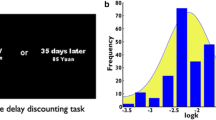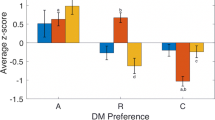Abstract
Rationale
Despite a national reduction in the prevalence of cigarette smoking, ~19 % of the adult US population persists in this behavior, with the highest prevalence among 18–25-year-olds. Given that the choice to smoke imposes a known health risk, clarification of brain function related to decision-making, particularly involving risk-taking, in smokers may inform prevention and smoking cessation strategies.
Objectives
This study aimed to compare brain function related to decision-making in young smokers and nonsmokers.
Methods
The Balloon Analogue Risk Task (BART) is a computerized risky decision-making task in which participants pump virtual balloons, each pump associated with an incremental increase in potential payoff on a given trial but also with greater risk of balloon explosion and loss of payoff. We used this task to compare brain activation associated with risky decision-making in smokers (n = 18) and nonsmokers (n = 25), while they performed the BART during functional magnetic resonance imaging (fMRI). The participants were young men and women, 17–21 years of age.
Results
Risk level (number of pumps) modulated brain activation in the right dorsolateral and ventrolateral prefrontal cortices more in smokers than in nonsmokers, and smoking severity (Heaviness of Smoking Index) was positively related to this modulation in an adjacent frontal region.
Conclusions
Given evidence for involvement of the right dorsolateral and ventrolateral prefrontal cortices in inhibitory control, these findings suggest that young smokers have a different contribution of prefrontal cortical substrates to risky decision-making than nonsmokers. Future studies are warranted to determine whether the observed neurobiological differences precede or result from smoking.



Similar content being viewed by others
References
Acheson A, de Wit H (2008) Bupropion improves attention but does not affect impulsive behavior in health young adults. Exp Clin Psychopharmacol 16:113–123. doi:10.1037/1064-1297.16.2.113
Addicott MA, Baranger DA, Kozink RV, Smoski MJ, Dichter GS, McClernon FJ (2012) Smoking withdrawal is associated with increases in brain activation during decision making and reward anticipation: a preliminary study. Psychopharmacol (Berl) 219(2):563–73. doi:10.1007/s00213-011-2404-3
Azizian A, Monterosso J, O'Neill JO, London ED (2009) Magnetic resonance imaging studies of cigarette smoking. Handb Exp Pharmacol 192:113–143. doi:10.1007/978-3-540-69248-5_5
Beckmann C, Jenkinson M, Smith S (2003) General multilevel linear modeling for group analysis in fMRI. NeuroImage 20:1052–1063. doi:10.1016/S1053-8119(03)00435-X
Bogg T, Fukunaga R, Finn PR, Borwn JW (2012) Cognitive control links alcohol use, trait disinhibition, and reduced cognitive capacity: evidence for medial prefrontal cortex dysregulation during reward-seeking behavior. Drug Alcohol Depend 122:112–118. doi:10.1016/j.drugalcdep.2011.09.018
Borland R, Yong HH, O'Connor RJ, Hyland A, Thompson ME (2010) The reliability and predictive validity of the Heaviness of Smoking Index and its two components: findings from the International Tobacco Control Four Country study. Nicotine Tob Res 12(Suppl):S45–50. doi:10.1093/ntr/ntq038
Bornovalova M, Cashman-Rolls A, O'Donnell J, Ettinger K, Richards J, deWit H, Lejuez C (2009) Risk taking differences on a behavioral task as a function of potential reward/loss magnitude and individual differences in impulsivity and sensation seeking. Pharmacol Biochem Behav 93:258–262. doi:10.1016/j.pbb.2008.10.023
Center for Disease Control and Prevention (2008) Cigarette smoking among adults—United States, 2006. MMWR Morb Mortal Wkly Rep 56:1157–1161
Centers for Disease Control and Prevention (2011) Vital signs: current cigarette smoking among adults aged ≥18 years—United States, 2005–2010. MMWR Morb Mortal Wkly Rep 60(33):1207–12
Chiu PH, Lohrenz TM, Montague PR (2008) Smokers' brains compute, but ignore, a fictive error signal in a sequential investment task. Nat Neurosci 11(4):514–20. doi:10.1038/nn2067. Epub 2008 Mar 2
Claus E, Hutchison K (2012) Neural mechanisms of risk taking and relationships with hazardous drinking. Alcohol Clin Exp Res 36:932–940. doi:10.1111/j.1530-0277.2011.01694.xC.R.E
Coggins CR, Murrelle EL, Carchman RA, Heidbreder C (2009) Light and intermittent cigarette smokers: a review (1989–2009). Psychopharmacology 207(3):343–363. doi:10.1007/s00213-009-1675-4
Dean A, Sugar C, Hellemann G, London ED (2011) Is all risk bad? Young adult cigarette smokers fail to take adaptive risk in a laboratory decision-making test. Psychopharmacology 215:801–811. doi:10.1007/s00213-011-2182-y
Fecteau S, Knoch D, Fregni F, Sultani N, Boggio P, Pascual-Leone A (2007) Diminishing risk-taking behavior by modulating activity in the prefrontal cortex: a direct current stimulation study. J Neurosci 27:12500–12505. doi:10.1523/JNEUROSCI.3283-07.2007
Fields S, Collins C, Leraas K, Reynolds B (2009) Dimensions of impulsive behavior in adolescent smokers and nonsmokers. Exp Clin Psychopharmacol 17(5):302–311. doi:10.1037/a0017185
Fukunaga R, Brown JW, Bogg T (2012) Decision making in the Balloon Analogue Risk Task (BART): anterior cingulated cortex signals loss aversion but not the infrequency of risky choices. Cogn Affect Behav Neurosci 12:479–490. doi:10.3758/s13415-012-0102-1
Galván A, Poldrack RA, Baker C, McGlennen K, London ED (2011) Neural correlates of response inhibition and cigarette smoking in late adolesence. Neuropsychopharmacology 36:970–978. doi:10.1038/npp.2010.235
Heishman S (1998) What aspects of human performance are truly enhanced by nicotine? Addiction 93:317–320. doi:10.1046/j.1360-0443.1998.93690712.x
Heishman S (1999) Behavioral and cognitive effects of smoking: relationship to nicotine addiction. Nicotine Tobacco Res Suppl 2:S143–S147. doi:10.1080/14622299050011971
Hommel B, Fischer R, Colzato L, van den Wildenberg W, Cellini C (2012) The effect of fMRI (noise) on cognitive control. J Exp Psychol Hum Percept Perform 38:290–301. doi:10.1037/a0026353
Hughes J, Hatsukami D (1986) Signs and symptoms of tobacco withdrawal. Arch Gen Psychiatry 43:289–294. doi: 10.1001/archpsyc.1986.018000T. Ida, R. Goto (2009). Interdependency among addictive behaviors and time/risk preferences: discrete choice model analysis of smoking, drinking and gambling. Journal of Economic Psychology, 30:608–621. http://dx.doi.org/10.1016/j.joep. 2009.05.003
Jacobsen LK, Mencl W, Constable R, Westerveld M, Pugh K (2007a) Impact of smoking abstinence on working memory neurocircuitry in adolescent daily tobacco smokers. Psychopharmacology 193:557–566. doi:10.1007/s00213-007-0797-9
Jacobsen LK, Slotkin T, Mencl W, Frost S, Pugh K (2007b) Gender-specific effects of prenatal and adolescent exposure to tobacco smoke on auditory and visual attention. Neuropsychopharmacology 32:453–464. doi:10.1038/sj.npp.1301398
Jarvik M, Madsen D, Olmstead R, Iwamoto-Schaap P, Elins J, Benowitz N (2000) Nicotine blood levels and subjective craving for cigarettes. Pharmacol Biochem Behav 66:553–558. doi:10.1016/S0091-3057(00)00261-6
Jenkinson M, Bannister P, Brady M, Smith S (2002) Improved optimization for the robust and accurate linear registration and motion correction of brain images. NeuroImage 17:825–841. doi:10.1006/nimg.2002.1132
Jentsch J, Woods J, Groman S, Seu E (2010) Behavioral characteristics and neural mechanisms mediating performance in a rodent version of the Balloon Analog Risk Task. Neuropsychopharmacology 35:1797–1806. doi:10.1038/npp.2010.47
Kubota K, Yamaguchi T, Abe Y, Fujiwara T, Hatazawa J, Matsuzawa T (1983) Effects of smoking on regional cerebral blood flow in neurologically normal subjects. Stroke 14:720–724. doi:10.1161/01.STR.14.5.720
Lejuez C, Read J, Kahler C, Richards J, Ramsey S, Stuart G, Strong D, Brown R (2002) Evaluation of a behavioral measure of risk taking: the Balloon Analogue Risk Task (BART). J Exp Psychol: Appl 8:75–84. doi:10.1016/j.neuron.2005.08.008
Lejuez C, Aklin W, Jones H, Richards J, Strong D, Kahler C, Read J (2003a) The Balloon Analogue Risk Task (BART) differentiates smokers and nonsmokers. Exp Clin Psychopharmacol 11:26–33. doi:10.1037/1064-1297.11.1.26
Lejuez C, Aklin W, Zvolensky M, Pedulla C (2003b) Evaluation of the Balloon Analogue Risk Task (BART) as a predictor of adolescent real-world risk-taking behaviours. J Adolesc 26:475–479. doi:10.1016/S0140-1971(03)00036-8
Lejuez C, Aklin W, Bornovalova M, Moolchan E (2005) Differences in risk-taking propensity across inner-city adolescent ever- and never-smokers. Nicotine Tob Res 7:71–79. doi:10.1080/14622200412331328484
Levin J, Frederick BB, Ross M, Fox J, von Rosenberg H, Kaufman M, Lange N, Mendelson J (2001) Influence of baseline hematocrit and hemodilution on BOLD fMRI activation. Magn Reson Imaging 19:1055–1062. doi:10.1016/S0730-725X(01)00460-X
Mendrek A, Monterosso J, Simon S, Jarvik M, Brody AL, Olmstead R, Domier C, Cohen M, Ernst M, London ED (2006) Working memory in cigarette smokers: comparison to non-smokers and effects of abstinence. Addict Behav 31:833–844. doi:10.1016/j.addbeh.2005.06.009
Poline J-B, Worsley KJ, Evans A, Friston K (1997) Combining spatial extent and peak intensity to test for activations in functional imaging. NeuroImage 5:83–96. doi:10.1006/nimg.1996.0248
Price C, Friston K (1999) Scanning patients with tasks they can perform. Hum Brain Mapp 8:102–108. doi:10.1002/(SICI)1097-0193
Rao H, Korczykowski M, Pluta J, Hoang A, Detre J (2008) Neural correlates of voluntary and involuntary risk taking in the human brain: an fMRI study of the Balloon Analog Risk Task (BART). NeuroImage 42:902–910. doi:10.1016/j.neuroimage.2008.05.046
Reyna VF, Farley F (2006) Risk and rationality in adolescent decision making: implications for theory, practice and public policy. Psychol Sci Public Interes 7(1):1–44. doi:10.1111/j.1529-1006.2006.00026
Romberger DJ, Grant K (2004) Alcohol consumption and smoking status: the role of smoking cessation. Biomed Pharmacother 58(2):77–83. doi:10.1016/j.biopha.2003.12.002
Rose J, McClernon F, Froeliger B, Behm F, Preud'homme X, Krystal A (2011) Repetitive transcranial magnetic stimulation of the superior frontal gyrus modulates craving for cigarettes. Biol Psychiatry 70:794–799. doi:10.1016/j.biopsych.2011.05.031
Schonberg T, Fox C, Mumford J, Congdon E, Trepel C, Poldrack R (2012) Decreasing ventromedial prefrontal cortex activity during sequential risk-taking: an FMRI investigation of the balloon analog risk task. Front Neurosci 6:80. doi:10.3389/fnins.2012.00080
Telzer EH, Fuligni AJ, Lieberman MD, Galván A (2013) Meaningful family relationships: Neurocognitive buffers of adolescent risk taking. J Cogn Neurosci 25:374–387. doi:10.1162/jocn_a_0031
U.S. Department of Health and Human Services (2012). Preventing tobacco use among youth and young adults: a report of the Surgeon General, 2012. U.S. DHHS, Office of the Surgeon General
Woolrich M (2008) Robust group analysis using outlier inference. NeuroImage 41:286–301. doi:10.1016/j.neuroimage.2008.02.042
Xu J, Mendrek A, Cohen M, Monterosso J, Rodriguez P, Simon S, Brody AL, Jarvik M, Domier C, Olmstead R, Ernst M, London ED (2005) Brain activity in cigarette smokers performing a working memory task: effect of smoking abstinence. Biol Psychiatry 58:143–150. doi:10.1016/j.biopsych.2005.03.028
Xu J, Mendrek A, Cohen M, Monterosso J, Simon S, Jarvik M, Olmstead R, Brody AL, Ernst M, London ED (2007) Effect of cigarette smoking on prefrontal cortical function in nondeprived smokers performing the Stroop Task. Neuropsychopharmacology 32:1421–1428. doi:10.1038/sj.npp.1301272
Acknowledgments
The research described in this article was funded, in part, by a grant from Philip Morris USA under UCLA contract 20063287. Additional funding was provided by an endowment from the Thomas P. and Katherine K. Pike, Chair in Addiction Studies, and a gift from the Marjorie M. Greene Trust. M Kohno was supported by an institutional training grant, T32 DA024635. All experimental procedures comply with current laws of the United States of America.
Conflict of interest
None.
Author information
Authors and Affiliations
Corresponding author
Additional information
Adriana Galván and Tom Schonberg contributed equally to this work.
Electronic supplementary material
Below is the link to the electronic supplementary material.
ESM 1
(PDF 57 kb)
Rights and permissions
About this article
Cite this article
Galván, A., Schonberg, T., Mumford, J. et al. Greater risk sensitivity of dorsolateral prefrontal cortex in young smokers than in nonsmokers. Psychopharmacology 229, 345–355 (2013). https://doi.org/10.1007/s00213-013-3113-x
Received:
Accepted:
Published:
Issue Date:
DOI: https://doi.org/10.1007/s00213-013-3113-x




